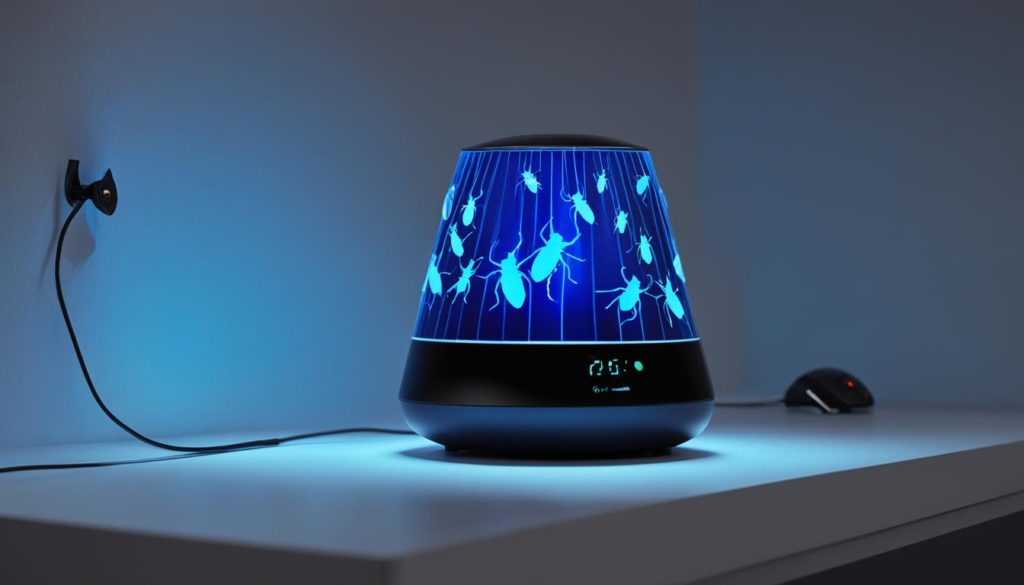62% of US homes battled a pest invasion last year! Yikes! Electronic and ultrasonic pest repellers promise a pest-free paradise with sound or electromagnetic waves. But do they really work? Let’s find out!
Electronic and ultrasonic pest repellers bother pests temporarily, but studies indicate they probably won’t eliminate an infestation completely. For long-term solutions, stick with traps, baits, or call a pest pro!
Key Takeaways:
-
Zap ’em or not? Electronic and ultrasonic pest repellers claim to scare away pests using sound or zaps, but research shows they might not be the best pest solution.
-
Sticking with the classics: Traps, baits, and calling a pest pro are more likely to kick out unwanted guests for good.
-
Prevention is key! To prevent insects from entering your home, seal cracks and store food in airtight containers.
-
Save your money and your sanity: Focus on sealing your home and using tried-and-true methods over electronic gadgets.
How Ultrasonic Pest Repellers Work
Ultrasonic pest repellers plug into your wall and emit high-pitched sounds that you can’t hear, but pests supposedly find annoying. The idea is that the noise drives them away. However, research suggests they may not be very effective and some pets can hear the high frequencies.
High-frequency sounds cause a specific reaction in pests, called the audiogenic seizure response. This means, in mice and rats, the noise can make them run aimlessly, have seizures, and sometimes die.
Ultrasonic pest repellers use these sounds to confuse rodents. The confusion makes it hard for them to find food, breed, make homes, or talk to each other. Without doing these things, they can’t survive or stay in the area.
These devices are popular because they are easy to use. They don’t make a sound humans can hear, so they won’t bother you. They also don’t need traps or poison. This makes them a kinder and greener way to control pests.
There are also electromagnetic and subsonic pest control devices. They work with different kinds of signals to affect various pests. Each type has its own way of controlling pests. This gives people different options to choose from, based on their needs.
Look at the diagram below to see how ultrasonic pest repellers work.
The Effectiveness of Ultrasonic Pest Repellers

Ultrasonic pest repellers may irritate pests with high-frequency sounds, but studies show they likely won’t eliminate an infestation. For long-term solutions, stick with traps, baits, or call a pest professional!
The effectiveness of ultrasonic pest repellers is debated. Some studies show they work against crickets to some extent but are ineffective against cockroaches, ants, and spiders.
At first, ultrasonic signals might affect pests, but over time, pests get used to the noise. Once they adapt, they ignore the repellers and keep invading spaces.
The performance of these repellers can drop because of obstacles like walls and furniture. These block or weaken the ultrasonic signals, limiting their reach across different home areas.
Using ultrasonic pest repellers raises safety issues. They can mess with phones, alarms, mute hearing aids, and bother pets with their high-frequency sounds.
“Warning letters have been issued to manufacturers by the Federal Trade Commission (FTC), emphasizing the need for scientific evidence to support the claims of efficacy made by ultrasonic pest repellers.”
The Federal Trade Commission (FTC) has warned manufacturers. They need scientific proof to claim these repellers work.
Before using ultrasonic pest repellers as the only pest control method, consider these limitations and issues.
Comparison of Ultrasonic Pest Repellers for Different Types of Pests
|
Pest |
Effectiveness |
|---|---|
|
Insects (Crickets) |
Some devices show limited efficacy |
|
Cockroaches |
Little to no effect |
|
Ants |
Little to no effect |
|
Spiders |
Little to no effect |
Despite the availability of ultrasonic pest repellers, it is important to approach pest control with caution and explore alternative methods that have proven effectiveness. Chemical pesticides, traps, and professional inspections are more reliable options that can better address pest infestations.
Do Ultrasonic Pest Repellers Really Work?
Manufacturers claim that ultrasonic pest repellers work, but there’s no strong scientific proof. Research shows these devices might affect pests a little, but only for a short while. For instance, bed bugs don’t react much differently whether or not you use a repeller. Mice start ignoring the ultrasonic sounds after just a few days. Sometimes, these devices can make things worse, like causing a 50% increase in mosquito bites. Although ultrasonic sounds can affect pests in lab tests, the devices sold in stores don’t effectively stop or get rid of pests.
|
Pest Type |
Efficacy of Ultrasonic Repellers |
|---|---|
|
Bed Bugs |
No significant difference compared to not using a repeller |
|
Rodents |
Quickly stop responding to ultrasonic sounds after a few days |
|
Mosquitoes |
Possible increase in mosquito bites by 50% |
It is important to consider these findings when deciding on a pest control method. While the concept of ultrasonic pest repellers may seem appealing, the lack of scientific evidence supporting their effectiveness raises doubts about their reliability. Instead, homeowners should explore alternative pest control options that have been proven to be more effective and reliable.
Safety Considerations and Impact on Pets
When using ultrasonic pest repellers, think about your pets’ safety. These devices produce sounds too high for humans to hear. Yet, pets like cats and rodents can hear them, unlike dogs. The long-term effects on pets are unknown, but they could cause neurological damage over time.
Before using such repellers at home, talk to a vet. They can tell you about the risks and benefits for your pets. Even though some say these devices are pet-safe, they might still bother or harm your pets. This is true if the pet can’t get away from the device.
Always put your pets’ safety first. Talk to a vet who knows about pet health.
|
Pets |
Frequency Range |
|---|---|
|
Cats |
Higher frequencies |
|
Dogs |
Lower frequencies |
|
Pet rodents |
Higher frequencies |
Alternative Pest Control Options

For pest control, there are better options than just using ultrasonic pest repellers. Homeowners can use chemical pesticides, traps, and get professional inspections. This approach helps keep homes free from pests.
Besides these methods, homeowners can also follow practical steps to prevent and get rid of pests.
-
Eliminate food sources: Storing pet food in sealed containers, cleaning up spills promptly, and removing dirty dishes can help reduce the attractiveness of a home to pests. By denying pests access to readily available food, their presence can be significantly diminished.
-
Seal cracks and openings: Pests find their way into homes through small cracks and openings. By sealing these entry points, including vents and drains, homeowners can prevent pests from infiltrating their living spaces.
-
Remove clutter: Pests thrive in areas with ample hiding spots. By decluttering the home, eliminating piles of rocks or sticks, and keeping storage areas organized, homeowners can make their surroundings less hospitable to pests.
-
Eliminate safe harbor areas: Pests often seek out safe harbor areas where they can hide and breed. By removing hiding spots such as brush piles, overgrown vegetation, and dense shrubs, homeowners can discourage pests from taking refuge on their property.
Avoid using broad-spectrum pesticides. They can harm helpful insects and upset nature’s balance. Homeowners should use pesticides that target specific pests instead. This protects other species.
Keeping a healthy predator population in the yard also controls pests naturally. Attracting birds, bats, and certain insects can help manage pest populations effectively.
While ultrasonic pest repellers seem convenient, other pest control methods are more reliable. These methods include removing pests’ food sources, blocking their entry points, and reducing clutter. Encouraging natural predators is also key.
For the best results, combine these strategies. Always use methods that are proven to work. It’s also wise to talk to pest control experts for advice tailored to your specific situation.
Conclusion
Electronic and ultrasonic pest repellers may seem like a perfect fix, but hold off on giving up traditional methods. These devices might only irritate pests temporarily and often don’t eliminate them completely. If pests are invading, it’s better to use traps, baits, or hire a pest control professional. These methods are more effective in getting rid of pests permanently.
Preventing pests is crucial. By sealing cracks and storing food in airtight containers, your home becomes less appealing to them. Instead of relying on electronic repellers, focus on making your home secure and use traps or baits when necessary. This approach will save you money and keep you sane.
FAQ
Are electronic and ultrasonic pest repellers effective in controlling pests?
The effectiveness of electronic and ultrasonic pest repellers is disputed. Studies have shown mixed results, with limited or temporary effects on pest behavior.
Do ultrasonic pest repellers work on insects like cockroaches and ants?
Ultrasonic pest repellers have shown limited effectiveness in repelling insects like crickets but little to no effect on cockroaches, ants, and spiders.
Can pests become habituated to ultrasonic pest repellers?
Yes, pests can become habituated to the noise emitted by ultrasonic pest repellers, rendering the devices ineffective in repelling them.
Are there safety concerns with ultrasonic pest repellers?
Safety concerns have been raised regarding the impact of ultrasonic pest repellers on phone conversations, hearing aids, and certain pets. Interference with phone conversations and muting of hearing aids have been reported.
Is there scientific evidence supporting the efficacy of ultrasonic pest repellers?
Scientific evidence supporting the efficacy of ultrasonic pest repellers is lacking. Studies have shown limited or temporary effects on pest behavior, and there is a need for more research to support the claims made by manufacturers.
Can ultrasonic pest repellers harm pets?
The impact of ultrasonic pest repellers on pets depends on their frequency range. While there is no clear research on long-term effects, there may be concerns about potential neurological damage in pets exposed to these devices for extended periods. It is advisable to consult a veterinarian before using ultrasonic pest repellers.
Are there alternative pest control options to consider?
Yes, there are alternative pest control options available. Chemical pesticides, traps, and professional inspections are more reliable and effective methods. Eliminating food sources, sealing cracks and openings, removing clutter, and maintaining a healthy predator population in the yard are practical measures to control pests.
Source Links
-
https://www.terminix.com/blog/diy/do-ultrasonic-pest-repellers-work/
-
https://www.forbes.com/home-improvement/pest-control/do-ultrasonic-pest-repellers-work/

Welcome to micegoneguide.com, your go-to resource for eliminating rats and mice. Say goodbye to rodent infestations with our expert tips and strategies. Visit us now and reclaim your space!

